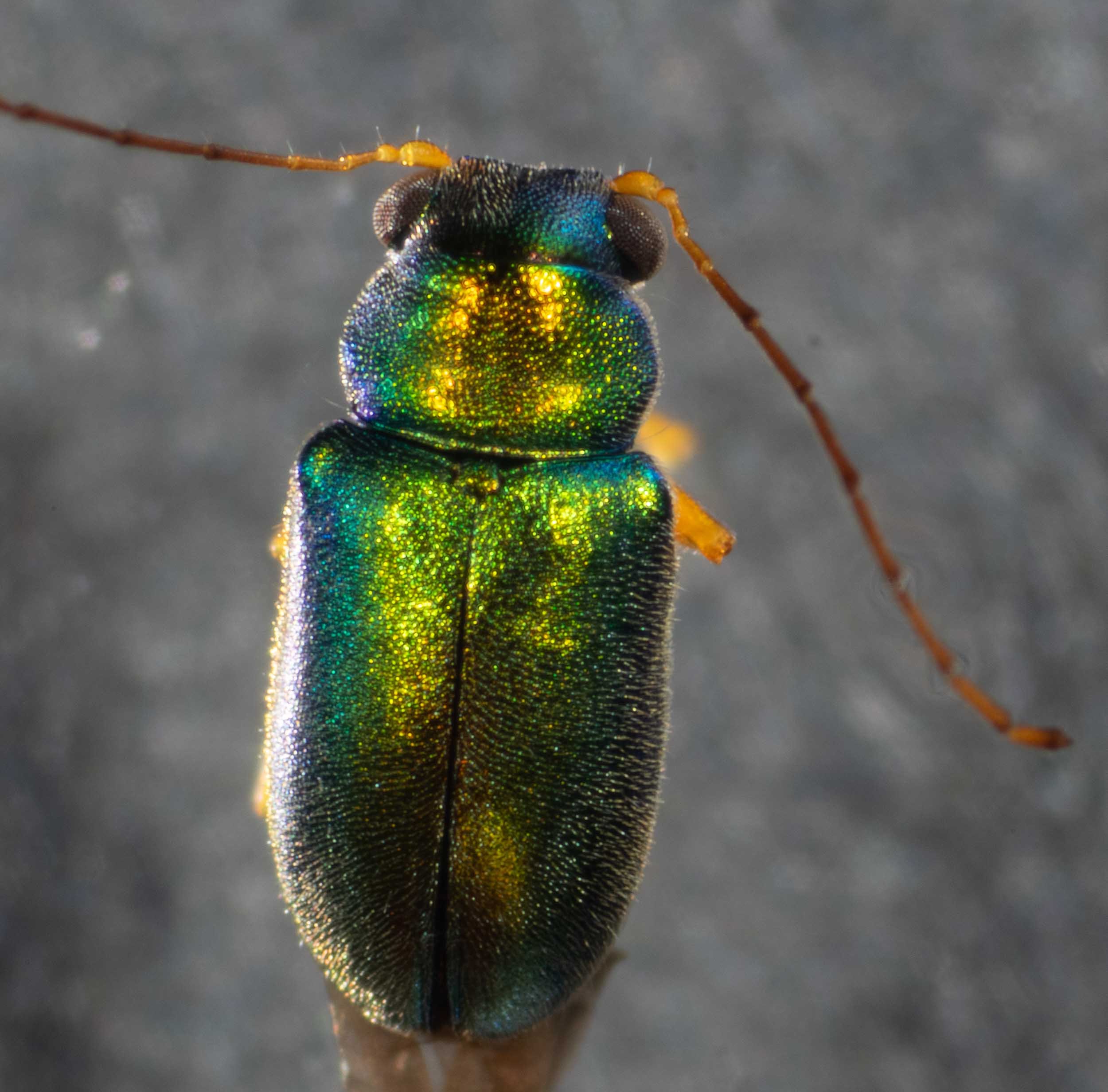Eboo (Chrysomelidae: Eumolpinae)

Workbook
Identification of metallic green/bronze chrysomelid beetles in malaise collection from 6-20 Feb, 2022
5 vivid green and 3 bronze beetles were found in this collection.
These were suspected to be Eboo viridula, a redescribed type species in the subfamily Eumolpinae (see Reid, A.M. 1993 The Coleopterists Bulletin 47: 61-67). Reid found that male E. viridula are vivid green, while the females are bronze.
4 of the males (“Eboo #1-4”) and 1 of the females (“Eboo #5”) were imaged. Legends in the following photos of these specimens highlight features described by Reid (1993) for genus Eboo and species E. viridula.
Where my specimens differ from Reid’s descriptions, I have indicated this difference with bold, italic font in my description.
Note that in all of the malaise trap specimens the aedegus and ovipositor was everted - presumably a result of immersion in absolute ethanol. This disrupted the structure of the male sexual structures, preventing analysis of their morphology. However the distal portion of the female’s ovipositor appeared to be intact.
Diagnostic characters for genus Eboo (from Reid, 1993)
eyes convex, laterally prominent (fig. A, I, N, O, W); internal margins with a deep but small rounded excavation by antennal bases (fig. B, O, X)
head without transverse or longitudinal grooves between or above eyes (fig. A, B, N, O)
at least a few dorsal setae on head and pronotum in shallow flat-bottomed circular pits (fig. C, D, L)
sides of pronotum finely bordered and evenly rounded (fig. A, C, I, J); base of pronotum much narrower than elytra across shoulders (fig. A); front angles of pronotum hidden from above by convex sides of dorsal surface (fig. A).
elytra not transversely rugose at sides (fig. A, I, J)
femora untoothed (fig. B, F, I, J, N, W, X); tibiae without spurs (fig. B, F, I, J, N, O, X); claws appendiculate (fig. G, O, X)
pygidium not longitudinally slotted (fig. B, W)
Description of E. viridula (from Reid, 1993)
Male:
length 2.5-3.5 mm; body colour fresh metallic green and moderately shining (fig.A, I, P)
antennal segments clear reddish-yellow (yellow) except vague spot at extreme apex of segment 6 (and rarely on other apical segments) and apical third to half of last segment black (or dark brown); antennae almost equal to body length, segments 3-10 subparallel-sided (fig. A, H, I, K, P, S)
maxillary palpi entirely reddish-yellow (yellow) except basal spot on ovoid last segment; labial palpi entirely reddish-yellow (yellow), last segment ovoid (fig. B, E, M, N, O, R, X)
dorsal pubescence recumbent, except a few raised setae at sides of elytra (fig. C, D, L, P, Q)
punctures of head and pronotum flat-bottomed with steep edges and slightly raised central setal pore; pronotum finely and closely punctured, without smooth impunctate areas and disc very slightly transversely depressed (fig. A, C, D, L, Q)
legs entirely reddish-yellow except for claws (fig. B, F, I, J, N, O, P, W, X)
sternites V and VI with a small median tuft of erect setae (fig. U, V).
Eboo #1 (Lightroom caption) iNat record OK
Eboo #2 (Lightroom caption) OK
Eboo #3 (Lightroom caption) iNat record - still in dish
Eboo #4 (Lightroom caption) OK
Eboo #6 (Lightroom caption) OK
Female:
Length 2.8-4.2mm (fig. Y)
Elytra and pronotum proportionately broader than in male, but punctation and pubescence identical (fig. Z, AA, BB, EE)
Body colour dull bronze with a purple or rarely dark green sheen (fig. Y, Z, AA)
Colour of antennae varying from segments 6-1 1 with at least apical half pitchy-brown to segments 1-2 and 5-11 almost entirely pitchy-brown (fig. Y, Z, AA)
Antennae about half length of body, with segments 6-11 apically expanded (fig. Y, Z, AA)
Maxillary and labial palpi coloured as male but subparallel (fig. Z, CC)
Legs dull red (yellow tibia, tarsus), with vague darker median area on femora (fig. Y, Z, DD)
Sternites without tufts of setae (fig. FF)
Sternite VII flat with simple convex apical margin (fig. Z)
Ovipositor with small apical stylus, paler than deeply pigmented apical half of coxite; a few long setae at sides and venter of coxite and a single long seta at apex of stylus (fig. GG)
proctiger split at apex with two pairs of long apical setae; paraprocts weak each with a row of 4-6 long setae (these structures obscured by ovipositor sheath); tergite VIII reduced to two faintly sclerotised strips and a few apical setae, sternite VIII similar but with long thin spiculum ??
Eboo #5 (Lightroom caption) iNat record
Eboo #7, 8 (Lightroom caption) females
not imaged but kept in ethanol in fridge
This is a workbook page … a part of our website where we record the observations and references used in making species identifications. The notes will not necessarily be complete. They are a record for our own use, but we are happy to share this information with others.








































